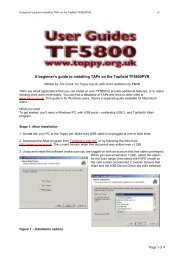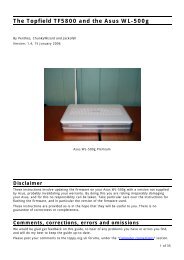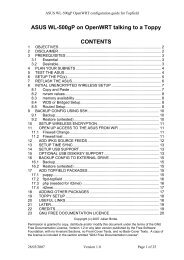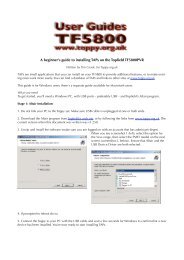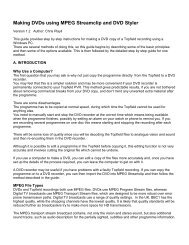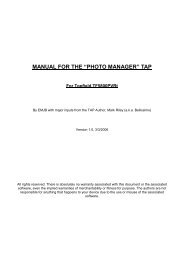Download - Toppy.org.uk
Download - Toppy.org.uk
Download - Toppy.org.uk
You also want an ePaper? Increase the reach of your titles
YUMPU automatically turns print PDFs into web optimized ePapers that Google loves.
Chipsets<br />
NEC Electronics Inc.<br />
VRC4372<br />
I/O Controller for the<br />
VR43xx Family<br />
NEC Electronics Inc.<br />
Salient Features<br />
<br />
<br />
<br />
<br />
<br />
<br />
<br />
<br />
<br />
<br />
PCI arbitration for six external and one internal<br />
PCI masters<br />
Timer and beeper source<br />
ISA-like I/O bus<br />
Four independent DMA channels<br />
Ten chip selects<br />
N-to-3 interrupt controller<br />
Interrupts generated from 14 input pins and two<br />
internal timers<br />
Test port to place chip in scan mode<br />
3.3-volt compliant and 5-volt tolerant<br />
33 MHz bus frequency<br />
CPUs Supported<br />
NEC VR43xx<br />
Product Overview<br />
The VRC4372 is a PCI-based I/O controller for a<br />
high-performance, low-cost system implementation based on<br />
the VR43xx microprocessor. The VRC4372 contains the<br />
functional blocks described below.<br />
PCI Bus Interface Controller<br />
• Compliance with 3.3-volt PCI interface standards (version<br />
2.1)<br />
• 5-volt PCI signaling in a controlled environment (with<br />
voltage spikes less than 7.6 volts and DC levels less than<br />
6.6 volts)<br />
• PCI bus arbitration for six external and one internal PCI<br />
masters<br />
I/O Controller<br />
• 16-bit ISA-like I/O bus and four independent DMA<br />
channels<br />
• Chip-select and control signals for interfacing to external<br />
peripheral chips<br />
• N-to-3 interrupt controller (interrupts from the keyboard<br />
and mouse, 14 input pins, two internal timers, and four<br />
DMA channels can be encoded onto one of three outgoing<br />
interrupt lines)<br />
• Four programmable DMA channels<br />
— Unique TCn, EOP, DREQ, and DACKn signals on<br />
each channel<br />
— Block or single transfers<br />
— Read or write requests<br />
— I/O-device-demanded service requests via DREQx<br />
— Software-initiated requests<br />
— Channel suspend via the MASKn register bit<br />
— I/O device transfer termination via EOP<br />
— Channel reload notification and termination<br />
notification via an interrupt<br />
— Efficient PCI bus data packing mode<br />
— Byte/short scattering/gathering capabilities (one per<br />
PCI word)<br />
Each channel has registers and status bits associated with its<br />
control and operation. A current address and current count<br />
register pair are used to address the current DMA buffer in<br />
PCI memory space. A reload start and reload count register<br />
pair provide a reload mechanism through which channel<br />
chaining can be accomplished. Fifth and sixth registers<br />
provide the channel with mode and status control.<br />
A global control register specifies global DMA attributes such<br />
as arbitration scheme selection.<br />
40



